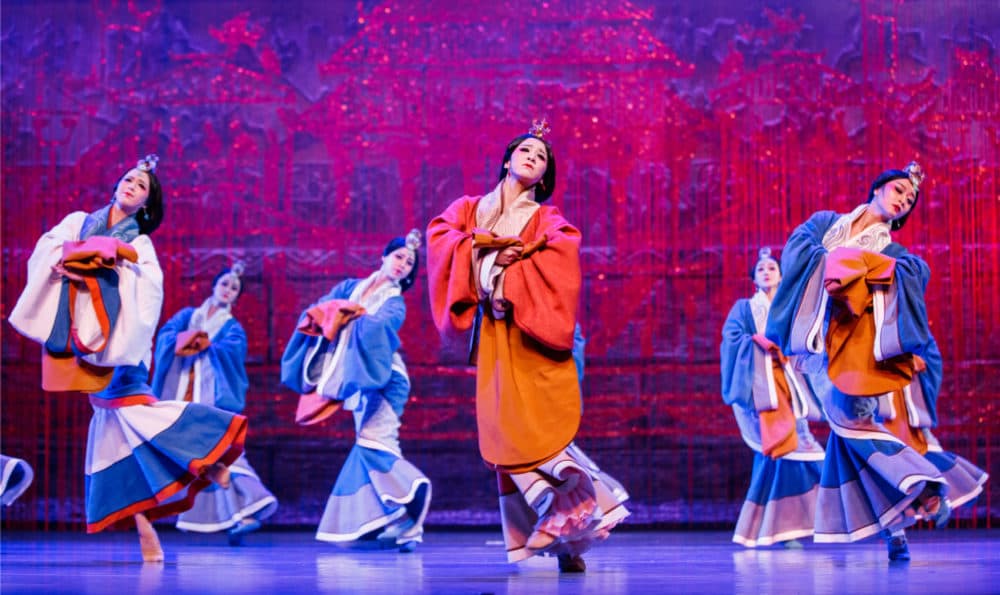Advertisement
'Princess Zhaojun': An Ancient Story Reframed For Modern Times

At 22, Wang Jiaxin is one of China’s top classical dancers. The Beijing Dance Academy, where she trained, is located in Beijing’s Haidian district — a world capital of modernity, known as China’s Silicon Valley. But every day, Wang trains to put herself in the mindset of a woman who lived over 2,000 years ago.
She listens to music that evokes the Han dynasty, and channels the thoughts and feelings of Wang Zhaojun, a Chinese heroine who entered into a political marriage that helped bring peace to China’s northern border.
Wang is the new lead in “Princess Zhaojun,” a dance drama from the China National Opera and Dance Drama Theater that’s coming to Boston’s Boch Center Shubert Theatre for two performances on March 16 and 17. It’s an epic stage production, with over 50 elite dancers and elaborate period costumes and sets.
The show premiered in 2016 and has been touring China, where Princess Zhaojun is a household name. The basics of the story are this: Wang Zhaojun was a royal consort in the court of Han Dynasty Emperor Yuan (49 B.C. - 33 B.C.). At the time, China’s northern borders were frequently contested by the Xiongnu, a tribal nomadic group in what’s known today as Inner Mongolia. Wang Zhaojun entered into a political marriage with Huhanye Chanyu, a Xiongnu chieftan, and worked as a Xiongnu queen to build friendly ties between the Xiongnu and the Han dynasty.
Her story has been interpreted in literature, poetry, film and song through the centuries. She’s known as one of China’s “four great beauties,” women whose extraordinary looks and influence over rulers changed the course of history. Princess Zhaojun was said to be so beautiful that upon seeing her, geese would fall stunned from the sky. She is often portrayed as a tragic figure — a woman who sacrifices her personal comfort to marry a barbarian and live in exile in the desert. She prioritizes country over self, and serves at great cost to her happiness.
Kong Dexin, choreographer and director for this show, sees Wang Zhaojun differently. “In my mind, she’s a strong woman with agency,” Kong said through a translator. “She’s not satisfied with her life [in the palace], so she chooses a different way of life, one that gives her a chance at happiness in the future. I think she’s very brave to choose her own path.”
While other productions may linger on Princess Zhaojun’s hometown and palace life, Kong’s version focuses on Princess Zhaojun’s transformation after she leaves the court and moves to the Xiongnu region. In her telling, the princess falls madly in love in her marriage and claims her space as a strong and influential monarch.
Advertisement
“Before I played this role, I knew she was a beautiful princess," Wang said through a translator. "Now I know much more about her inner life as well.”
The U.S. tour of “Princess Zhaojun” was organized by the state-owned China Arts and Entertainment Group as part of “Image China,” an initiative to present Chinese arts and culture abroad. Since the program started in 2009, “Image China” has toured dance dramas like “The Legend of Mulan” and “Dragon Boat Racing” to New York and Washington, D.C.
Kong says the scenery, music, costumes and choreography are traditional, designed to transport viewers back 2,000 years to the Han Dynasty. But it is inevitably created and performed from the perspective of modern people.
Kong, who identifies as a 77th-generation descendant of the Chinese philosopher Confucius, also directed and choreographed the China National Opera & Dance Drama Theater’s production of “Confucius,” which premiered in 2013, and toured the U.S. in 2017. The opulent production aimed to “[reflect] the inner and outer struggles of Confucius in expressive passages of dance and song,” a retelling that challenged “the [traditional] Chinese view of Confucius as very serious and very staid,” Xu Ning, an executive at the Opera, told the New York Times.
The revival of stories like Princess Zhaojun and Confucius are recent examples of a long-term effort by China to align historical narratives with today’s party lines and values. Princess Zhaojun represents a storyline that casts China's conflict with its ethnic minorities as ancient history, long-resolved; their descendants and lands have been living in harmony with, and as a part of, China for millennia.
The Princess Zhaojun dance drama features a young classical dancer in a career-making role, and recasts a historical figure as one that inspires and fits our modern times. The princess is a woman who chooses her own path to happiness. What’s right for her personally also happens to be right for her country.
China National Opera & Dance Drama Theater will perform "Princess Zhaojun" at the Boch Center Shubert Theatre on March 16 and 17. The U.S. engagement of "Princess Zhaojun" is presented by China Arts and Entertainment Group Ltd. and is part of Image China.
With additional translation help from Shu Chen Huang.